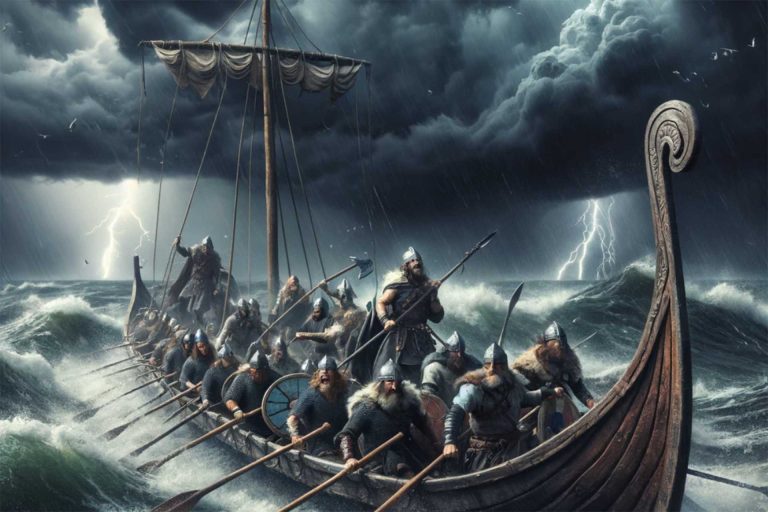10 of Napoleon’s Greatest Military Victories and Defeats: A Tale of Genius and Overreach
Napoleon’s greatest military victories and defeats are defining moments in European history, painting a portrait of a leader whose strategic acumen was as remarkable as his eventual downfall. Napoleon Bonaparte, a name synonymous with military genius and imperial ambition, carved a legacy that is as much about his breathtaking triumphs as it is about his dramatic defeats. His military campaigns reshaped the map of Europe, bringing about monumental shifts in power dynamics that reverberated long after his era. From the rolling hills of Austerlitz to the fateful fields of Waterloo, each battle under his command was a testament to his tactical brilliance and, at times, to his strategic miscalculations.
This journey through ten of Napoleon’s most significant battles offers a dual perspective on the man who dominated early 19th-century Europe. On the one hand, we see a commander capable of orchestrating decisive victories that stunned his contemporaries, showcasing innovation on the battlefield that would influence military tactics for generations. On the other, we witness the limitations of ambition, where overreach and underestimation lead to crushing defeats. Through these victories and losses, the figure of Napoleon emerges not just as a conqueror but as a complex character in the grand narrative of history.
Napoleon’s Greatest Military Victories
The Battle of Austerlitz
December 2, 1805
French Empire
Commanders: Napoleon Bonaparte
Strength: 65,000-75,000
Casualties & Losses: 8,852 (1,288 Killed – 6,991 Wounded – 573 Captured)
Russian & Austrian Empires
Commanders: Alexander I & Francis II
Strength: 73,000-89,000
Casualties & Losses: 27,000-36,000 (15,000-16,000 Killed or Wounded – 12,000-20,000 Captured)

The Battle of Austerlitz, fought on December 2, 1805, is a hallmark of military strategy and is often regarded as one of Napoleon’s greatest military victories. In this monumental confrontation, Napoleon, with his Grande Armée, faced a formidable coalition of Russian and Austrian forces. The battle, occurring near Austerlitz (now in the Czech Republic), played a crucial role in the War of the Third Coalition, part of the broader Napoleonic Wars.
Prelude to Austerlitz
Napoleon’s strategic foresight marked the lead-up to the Battle of Austerlitz. Following his coronation as Emperor of France, Napoleon aimed to consolidate his power and counter the growing threats from Austria and Russia. He swiftly moved his army across Europe, engaging the enemy in various skirmishes, culminating in the decisive encounter at Austerlitz. His audacious crossing of the Rhine and rapid advance demonstrated his ability to mobilize and maneuver vast forces with unprecedented speed.
The Strategic Terrain
The battlefield’s terrain played a pivotal role in the battle’s outcome. Napoleon cleverly chose the ground near Austerlitz, exploiting its undulating hills and the Pratzen Heights, a dominant feature of the landscape. He anticipated that the coalition forces, underestimating him, would attempt to capitalize on the perceived French vulnerability by attacking his right flank. This miscalculation would become the linchpin of Napoleon’s triumph.
Tactical Brilliance
On the day of the battle, Napoleon’s tactics were a masterclass in deception and exploitation of enemy weaknesses. He feigned weakness on his right, drawing the bulk of the coalition army toward the Pratzen Heights, thereby thinning their line. At the opportune moment, he launched a ferocious counterattack on the Heights, effectively splitting the enemy forces and sowing chaos in their ranks. The French army’s coordinated movements and effective use of artillery proved devastating.
The Aftermath and Impact
The victory at Austerlitz was not just a tactical achievement; it was a strategic masterstroke that reshaped the European political landscape. It led to the Treaty of Pressburg, significantly weakening the Austrian Empire and dissolving the Holy Roman Empire, a cornerstone of European politics for centuries. The battle underscored Napoleon’s military genius and solidified his reputation as one of history’s great commanders.
Historical Accounts and Legacy
Contemporary accounts of Austerlitz often marvel at the precision and audacity of Napoleon’s plan. The battle has been extensively analyzed and documented, not just for its immediate impact but for its lasting contributions to military strategy. It remains a case study in military academies worldwide, a testament to Napoleon’s innovative approach to warfare and his ability to leverage terrain and psychology in battle.
In retrospect, the Battle of Austerlitz exemplifies Napoleon’s military prowess at its peak. It was a display of strategic foresight, tactical ingenuity, and bold leadership that forever changed the face of European warfare.
The Battle of Jena-Auerstedt
October 14, 1806
French Empire
Commanders: Napoleon Bonaparte
Strength: 66,000
Casualties & Losses: 12,000-13,100
Prussia & Saxony
Commanders: Prince of Hohenlohe & Duke of Brunswick
Strength: 119,000
Casualties & Losses: 39,000-42,000
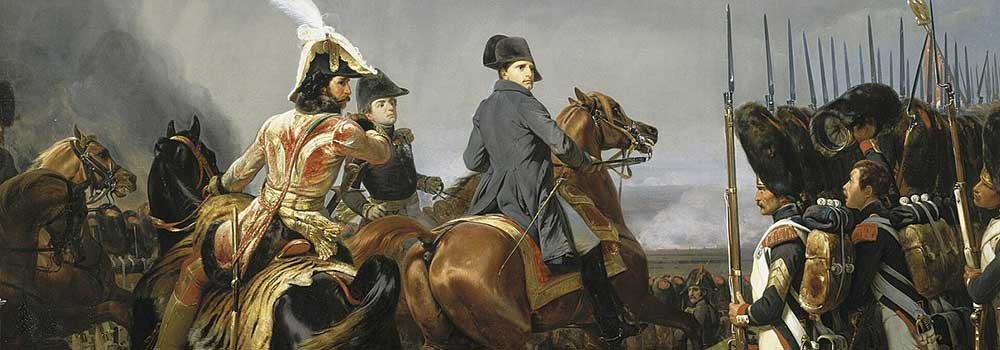
The Battle of Jena-Auerstedt fought on October 14, 1806, stands out as a significant example of Napoleon Bonaparte’s military genius, where he decisively defeated the Prussian army. This dual battle, fought simultaneously at Jena and Auerstedt, not only displayed Napoleon’s tactical prowess but also marked the beginning of the end for the Prussian military dominance in Europe.
Background to the Battle
The growing animosity between Napoleonic France and Prussia precipitated the battle. After the humiliation of the Austrians at Austerlitz, Prussia, which had remained neutral, felt increasingly threatened by Napoleon’s expansion. Eager to curtail French influence and assert its power, Prussia declared war on France. Napoleon responded by swiftly marching his Grande Armée into Prussian territory, setting the stage for the confrontation at Jena and Auerstedt.
The Battlefield and Tactics
The terrain played a crucial role in the battle’s outcome. At Jena, the French faced the Prussian main army. The battlefield comprised rolling hills and a river valley, which Napoleon used to his advantage. He deployed his forces to mask their actual numbers, tricking the Prussians into underestimating the size of the French army. His strategy involved using the corps system effectively, allowing for rapid, coordinated movements that could surprise and overwhelm the enemy.
Simultaneously, at Auerstedt, Marshal Louis Nicolas Davout confronted a more significant Prussian force. Despite being outnumbered, Davout’s troops demonstrated exceptional discipline and resilience, managing to hold off and eventually repel the Prussian advances.
The Importance and Impact of the Battle
The twin victories at Jena and Auerstedt were pivotal. They not only showcased the superiority of French military tactics under Napoleon but also shattered the myth of Prussian invincibility. The crushing defeat led to a rapid French advance, culminating in the capture of Berlin and leaving the Prussian state on the brink of collapse. The battle demonstrated the effectiveness of Napoleon’s modernized army and his ability to orchestrate large-scale fighting across multiple fronts.
Aftermath and Historical Accounts
The aftermath of Jena-Auerstedt saw a significant shift in European power dynamics. The Prussian army was effectively neutralized as a threat and was forced to undergo substantial reforms. Accounts of the battle often highlight the mismatch between the old Prussian military doctrine and Napoleon’s innovative approach to warfare.
Contemporary observers and later historians have dissected the battle to understand Napoleon’s military strategies. The Battle of Jena-Auerstedt remains a crucial study in the evolution of warfare, exemplifying how strategic insight, terrain utilization, and troop mobility can decisively impact the outcome of a battle.
In sum, the Battle of Jena-Auerstedt not only solidified Napoleon’s reputation as a master tactician but also redefined the nature of European warfare, signaling a new era of military organization and strategy.
The Battle of Marengo
June 14, 1800
French Republic
Commanders: Napoleon Bonaparte
Strength: 28,000
Casualties & Losses: 5,600 (1,100 Killed – 3,600 Wounded – 900 Captured)
Habsburg Monarchy
Commanders: Michael von Melas & Peter Ott
Strength: 30,000
Casualties & Losses: 14,000 (6,000 Killed or Wounded – 8,000 Captured)
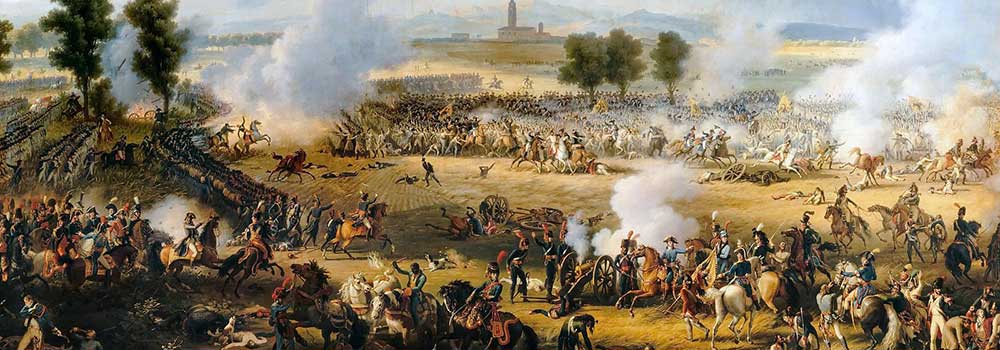
The Battle of Marengo stands as one of Napoleon Bonaparte’s most significant military victories, marking a pivotal moment in the Second Coalition War. This battle, which took place near the small village of Marengo in Northern Italy, played a crucial role in establishing French dominance over the region and demonstrated Napoleon’s strategic ingenuity in the face of seemingly insurmountable odds.
Prelude to the Battle
The battle was a key episode in the broader context of the Second Coalition War, a series of conflicts initiated by European monarchies against Revolutionary France. Napoleon, aiming to consolidate French gains and exert control over Northern Italy, faced a formidable Austrian army led by General Michael von Melas. The Austrians sought to drive the French out of Italy and restore the status quo before the French Revolution.
The Battlefield and Its Challenges
The terrain of Marengo consisted of flat plains interspersed with small rivers and villages, which played a significant role in the battle’s dynamics. The open fields provided little cover, making the armies vulnerable to artillery and cavalry charges. Napoleon utilized the landscape effectively, deploying his forces strategically to maximize their impact.
Clash of Tactics
The battle began with the Austrians launching a surprise attack on the French forces. Initially, the French were pushed back, with the Austrians gaining ground. Napoleon’s tactical response was characterized by rapid redeployment of his troops and effective use of reserve forces. In a daring move, he ordered a counterattack in the afternoon, bringing in fresh troops under General Louis Desaix. The timely arrival of these reinforcements turned the tide, leading to a decisive French victory.
Significance of the Victory
The Battle of Marengo was more than just a military triumph; it was a strategic victory with far-reaching implications. It secured French control over Northern Italy and bolstered Napoleon’s position as an army leader. The success also led to the signing of the Treaty of Lunéville in 1801, further expanding French influence in Europe.
Historical Accounts and Legacy
Accounts of the Battle of Marengo highlight the narrow margin by which victory was achieved and the crucial role played by Desaix, who was ultimately killed in the battle. Napoleon’s ability to recover from an initial setback and turn it into a stunning victory is a testament to his military genius.
In historical memory, the Battle of Marengo solidified Napoleon’s reputation as a master tactician capable of winning battles against the odds. It exemplifies his ability to adapt to changing battlefield conditions and make decisive, game-changing maneuvers.
The victory at Marengo not only reshaped the political landscape of Italy but also reinforced the image of Napoleon as an unstoppable force in European warfare, setting the stage for his future campaigns and eventual rule over much of the continent.
The Battle of Ulm
October 16–19, 1805
French Empire
Commanders: Napoleon Bonaparte & Michel Ney
Strength: 80,000
Casualties & Losses: 1,500 Killed or Wounded
Russian & Habsburg Monarchy
Commanders: Karl Mack von Leiberich & Johann I Joseph
Strength: 40,000
Casualties & Losses: 31,000 (4,000 Killed or Wounded – 27,000 Captured)

The Battle of Ulm, occurring in October 1805, is celebrated as one of Napoleon Bonaparte’s most remarkable strategic triumphs, where he effectively encircled and captured a substantial Austrian army. This confrontation was less a traditional battle and more a series of maneuvers showcasing Napoleon’s innovative warfare approach.
Prelude to Ulm
The battle formed part of the War of the Third Coalition, a conflict initiated by European powers, including Austria and Russia, to curb Napoleon’s growing influence. The Austrian army, under General Karl Mack von Leiberich, moved into Bavaria, planning to link up with Russian forces for a joint offensive against the French. In seizing the initiative, Napoleon rapidly marched his Grande Armée from the English Channel across central Europe to Bavaria, aiming to confront the Austrians before they could unite with their Russian allies.
The Battlefield and Tactics
The area around Ulm presented a varied terrain, with the Danube River playing a crucial role. Napoleon skillfully used the river and the hilly landscape to mask his army’s movements, confusing and outmaneuvering the Austrian forces. The French army’s swift and secretive march allowed them to encircle the town of Ulm, where the Austrian army was positioned, effectively cutting off their escape routes.
Napoleon’s tactics were characterized by speed, surprise, and using interior lines to concentrate his forces rapidly against parts of the scattered Austrian army. In contrast, General Mack’s strategy was marked by indecision and a failure to anticipate Napoleon’s movements adequately. The Austrian forces were strung out and unable to consolidate and were quickly surrounded by the faster-moving French forces.
The Outcome and Its Importance
The culmination of the Battle of Ulm was the surrender of General Mack and about 30,000 Austrian troops. The battle is significant not only for the scale of the victory but for the minimal bloodshed involved in achieving it. It demonstrated Napoleon’s ability to win decisive victories through maneuvering and intelligence rather than sheer force.
Impact on the War
The victory at Ulm had far-reaching consequences. It left the road to Vienna open for the French and significantly weakened the Austrian military’s standing in the war. This victory also set the stage for the subsequent Battle of Austerlitz, where Napoleon would again display his military prowess.
Historical Accounts
Contemporary and subsequent accounts of the Battle of Ulm often focus on Napoleon’s strategic ingenuity and Mack’s lack of tactical response. The encirclement of Ulm is regarded as a classic example of using maneuver warfare to achieve overwhelming victory.
In sum, the Battle of Ulm is a testament to Napoleon’s brilliance as a military strategist, demonstrating his ability to achieve decisive victories with minimal combat. It remains a key study in military tactics, emphasizing the importance of speed, intelligence, and strategic foresight in warfare.
The Battle of Wagram
July 5-6, 1809
France, Bavaria, Saxony, Italy
Commanders: Napoleon Bonaparte
Strength: 154,000-171,939
Casualties & Losses: 25,000-40,000
Austria
Commanders: Archduke Charles
Strength: 136,000–173,000
Casualties & Losses: 26,000-41,250
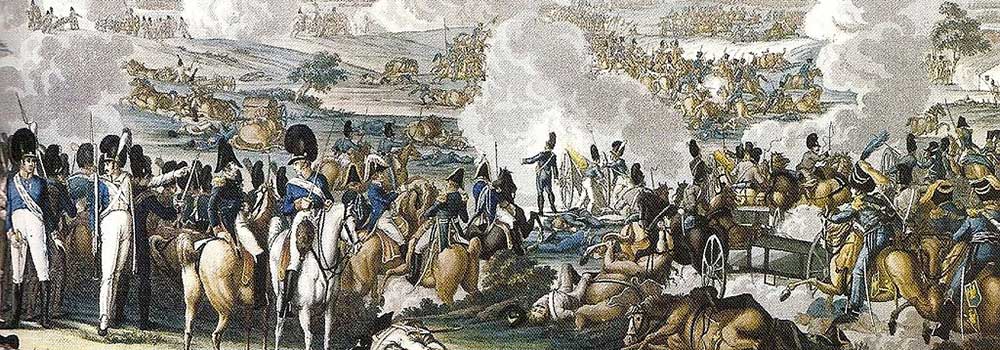
The Battle of Wagram was fought near the town of Wagram in Austria and was one of the largest and most significant battles of the Napoleonic Wars. This epic confrontation between the French Empire under Napoleon Bonaparte and the Austrian Empire led to the Treaty of Schönbrunn, which cemented French dominance over Central Europe.
Background to the Battle
In the broader context of the War of the Fifth Coalition, the Battle of Wagram was decisive in Napoleon’s campaign against the Austrian Empire. Following the French defeat at Aspern-Essling, Napoleon sought to deliver a conclusive blow to the Austrians. The conflict was part of his larger strategy to establish French hegemony in Europe and counter the persistent threats posed by the coalition forces.
The Battlefield and Its Influence
The battlefield at Wagram was characterized by flat, open plains, which allowed for large-scale maneuvers of infantry, cavalry, and artillery. This terrain was conducive to deploying massive armies and utilizing heavy artillery, both of which played significant roles in the battle. The flatness of the land offered little natural cover, making the troops highly vulnerable to artillery fire and cavalry charges.
Tactics and Engagement
Napoleon’s tactics at Wagram showcased his ability to adapt and innovate. He employed a grand battery, a massive concentration of artillery, to soften the enemy lines, followed by coordinated infantry and cavalry assaults. Under the command of Archduke Charles, the Austrians adopted a defensive stance, absorbing the French attacks while attempting to outflank Napoleon’s army.
One of the battle’s critical moments was the French use of the corps system to execute a massive, concentrated attack on the Austrian center. This maneuver eventually led to the breaking of the Austrian lines.
Significance and Aftermath
The Battle of Wagram was crucial for several reasons. It was one of the most significant battles in troop engagement during the Napoleonic era and marked an important turning point in the War of the Fifth Coalition. The French victory forced Austria to sue for peace, leading to the Treaty of Schönbrunn. This treaty significantly weakened Austria and expanded French influence in Central Europe, altering the European political landscape.
Historical Perspectives
Accounts of the Battle of Wagram often emphasize the scale of the conflict and the casualties involved. The battle is remembered for its sheer size, the intensity of the fighting, and the strategic insight displayed by Napoleon. It has been extensively analyzed in military history for its tactical innovations, particularly Napoleon’s use of artillery and the corps system.
In conclusion, the Battle of Wagram is a testament to Napoleon’s military capabilities and quest for European dominance. It was a battle that not only showcased his tactical genius but also highlighted the human cost of his ambitious endeavors.
Napoleon’s Greatest Military Defeats
The Battle of Waterloo
June 18, 1815
France
Commanders: Napoleon Bonaparte & Michel Ney
Strength: 72,000-73,000
Casualties & Losses: 33,000 (25,000 Killed or Wounded – 8,000 Captured)
United Kingdom, Prussia, Netherlands, Hanover, Nassau, Brunswick
Commanders: Arthur Wellesley, 1st Duke of Wellington & Gebhard Leberecht von Blücher
Strength: 118,000-120,000
Casualties & Losses: 21,700 Killed or Wounded

The Battle of Waterloo remains one of the most famous battles in history and marked the final defeat of Napoleon Bonaparte. This pivotal conflict, which pitted Napoleon’s forces against the allied armies of the British, led by the Duke of Wellington, and the Prussians, under Field Marshal Gebhard Leberecht von Blücher, ultimately led to Napoleon’s exile to Saint Helena and reshaped the European political landscape.
The Road to Waterloo
After his forced abdication and exile to Elba, Napoleon made a dramatic return to power in 1815, a period known as the Hundred Days. His return reignited the conflicts with the European powers that had united against him. Determined to restore his empire, Napoleon quickly engaged the Allied forces before they could fully consolidate.
The Strategic Terrain
Gentle slopes and ridges characterized Waterloo’s battlefield in present-day Belgium. The most notable geographical features were the Hougoumont farmhouse to the west and the village of La Haye Sainte in the center. These structures became critical in the battle, serving as solid defensive positions. The ridge on which the British army was positioned gave them a tactical advantage, allowing them to deploy their troops effectively and use the terrain to shield them from French artillery.
Clash of Tactics
Napoleon’s strategy at Waterloo involved breaking through the center of the allied lines, intending to separate and defeat the British and Prussian armies in detail. The Duke of Wellington, known for his defensive prowess, established strong positions along the ridge, using infantry squares to counter the French cavalry and protect his lines from artillery fire.
As the battle progressed, heavy fighting ensued around key locations like Hougoumont and La Haye Sainte. Napoleon’s attempts to break through the British lines were met with fierce resistance. The late arrival of Blücher’s Prussian forces turned the tide, attacking Napoleon’s right flank and eventually forcing the French into a chaotic retreat.
The Aftermath and Its Impact
The defeat at Waterloo ended Napoleon’s rule and military career, leading to his second abdication and exile. The battle had significant repercussions, leading to the restoration of the Bourbon monarchy in France and the redrawing of the European map at the Congress of Vienna. Waterloo symbolized the end of an era dominated by Napoleon’s military campaigns and ushered in a period of relative peace in Europe.
Contemporary Accounts
Contemporary accounts of the Battle of Waterloo often highlight the intense fighting, the high casualties, and the dramatic end to Napoleon’s ambitions. The battle has been extensively analyzed and discussed in numerous military studies, memoirs, and diaries, providing a detailed picture of the tactics, leadership, and personal bravery displayed on both sides.
Waterloo remains a symbol of the culmination of the Napoleonic Wars and a testament to the complexities of military strategy, the vagaries of war, and the end of one of history’s most iconic military careers.
The Battle of Leipzig
October 16-19, 1813
French and the Confederation of the Rhine (Baden,Duchy of Warsaw, Italy, Westphalia, Naples, Saxony, Württemberg)
Commanders: Napoleon Bonaparte
Strength: 225,000
Casualties & Losses: 60,000-79,000 (38,000 Killed and wounded – 30,000–36,000 captured (15,000 wounded) – 5,000–6,000 defected)
Russia, Austria, Prussia, Sweeden, Mecklenburg-Schwerin, Saxony, Württemberg, United Kingdom
Commanders: Alexander I & Karl von Schwarzenberg
Strength: 365,000
Casualties & Losses: 60,000-79,000 (38,000 Killed and wounded – 54,000-80,000

The Battle of Leipzig, also known as the Battle of the Nations, fought from October 16 to 19, 1813, stands as one of the most extensive and decisive engagements in the Napoleonic Wars. This monumental battle, which saw the forces of Napoleon Bonaparte pitted against the coalition armies of Russia, Prussia, Austria, and Sweden, marked a significant turning point, leading to the eventual downfall of Napoleon’s empire.
The Prelude to Leipzig
In the wake of the disastrous Russian campaign of 1812, Napoleon faced a revitalized and determined coalition of European powers. The Allies, seeking to capitalize on Napoleon’s weakened position, aimed to liberate German territories under French control and ultimately drive Napoleon back to France. Leipzig became the focal point of this grand strategy.
Terrain and Tactical Maneuvers
The terrain around Leipzig was diverse, featuring villages, forests, and rivers, which played a significant role in the battle. The coalition forces effectively utilized the landscape to encircle the French army gradually. Napoleon, known for his ability to manipulate terrain to his advantage, found himself constrained by the geography and the overwhelming numbers of the coalition forces.
Both sides employed a mix of tactics, including massive infantry assaults, cavalry charges, and artillery bombardments. Napoleon attempted to break the coalition lines and force a decisive victory, but the sheer number of coalition troops and their well-coordinated maneuvers made this increasingly difficult.
The Battle’s Significance
The Battle of Leipzig was one of the largest battles of the 19th century, involving over half a million soldiers and resulting in significant casualties on both sides. It was the first time Napoleon faced such a broad coalition, including armies from across Europe united against him. The battle was a testament to the growing European resistance against French hegemony and demonstrated the coalition’s commitment to defeating Napoleon.
Impact on the Napoleonic Wars
The defeat at Leipzig was catastrophic for Napoleon. It led to his retreat from Germany, the loss of his control over Central Europe, and the eventual invasion of France by the coalition forces. The battle marked the beginning of the end of the First French Empire and set the stage for Napoleon’s abdication in April 1814.
Historical Accounts and Legacy
Contemporary and later accounts of the Battle of Leipzig often emphasize its scale and the complex logistics of managing such large armies. The battle is remembered for the cooperation between the coalition armies and the significant role played by the newly formed German corps fighting alongside the allies.
In retrospect, the Battle of Leipzig remains a significant study in coalition warfare and is a vivid example of Napoleon’s strategic challenges in facing a united Europe. It remains a critical moment in military history, symbolizing the collective effort to reshape the European order in the wake of Napoleon’s expansive ambitions.
The Battle of Trafalgar
October 21, 1805
France & Spain
Commanders: Pierre Villeneuve & Federico Gravina
Strength: 33 ships of the line
5 frigates
2 brigs
2,632 guns
30,000 men
Casualties & Losses: 4,395 killed
2,541 wounded
7,000–8,000 captured
21 ships of the line captured
1 ship of the line destroyed
United Kingdom
Commanders: Horatio Nelson & Cuthbert Collingwood
Strength: 27 ships of the line
4 frigates
1 schooner
1 cutter
2,148 guns
17,000 men
Casualties & Losses: 458 killed
1,208 wounded
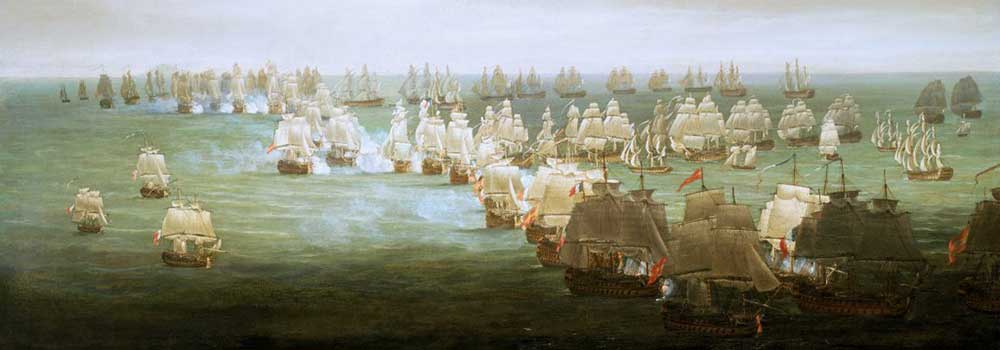
The Battle of Trafalgar stands as a defining moment in naval warfare and a significant setback in Napoleon Bonaparte’s ambitions to dominate Europe. This naval engagement, which pitted the French and Spanish fleets against the British Royal Navy, highlighted the strategic importance of maritime power and significantly altered the course of the Napoleonic Wars.
The Prelude to Trafalgar
Napoleon’s plan to invade Britain hinged on achieving naval superiority in the English Channel. Under Admiral Villeneuve, the French and Spanish fleets were to break the British naval blockade and enable the crossing of the French army. However, the British Royal Navy, led by Admiral Horatio Nelson, was determined to thwart Napoleon’s plans and maintain its dominance at sea.
The Battlefield at Sea
The battle took place near Cape Trafalgar, off the southwest coast of Spain. The open sea provided a vast and challenging battlefield, where weather and wind conditions played a crucial role. The British fleet, utilizing superior naval tactics and benefiting from the wind conditions, cut through the Franco-Spanish line, disrupting their formation and communication.
Tactical Innovations and Execution
Admiral Nelson employed a bold and unconventional tactic known as crossing the T, where he led his fleet in two columns perpendicular to the enemy line. This maneuver allowed the British ships to rake the enemy with broadsides while minimizing their exposure to return fire. In contrast, the Franco-Spanish fleet struggled with coordination and failed to execute their battle plan effectively.
Significance and Outcome
The Battle of Trafalgar was a decisive victory for the British. It annihilated Napoleon’s hopes of invading Britain and ensured British naval supremacy for the remainder of the Napoleonic Wars. The victory at Trafalgar had far-reaching implications, preventing France from challenging British control of the seas and safeguarding Britain from the threat of invasion.
Aftermath and Historical Perspectives
The battle profoundly impacted Napoleon’s strategy, forcing him to abandon his plans for a maritime empire and shift his focus to continental Europe. Admiral Nelson, killed during the battle, became a celebrated hero in Britain. His innovative tactics and leadership at Trafalgar were widely studied and admired in naval circles.
Contemporary accounts and later analyses of the Battle of Trafalgar focus on Nelson’s tactical genius and the superiority of British seamanship. The battle has been immortalized in numerous historical works, paintings, and memorials, celebrating it as a pivotal event in British naval history.
In summary, the Battle of Trafalgar is a testament to the importance of naval power in shaping world events. It marked a turning point in the Napoleonic Wars and underscored the strategic prowess of the British Royal Navy.
The Russian Campaign of 1812
June 24 – December 14, 1812
French Empire & The Rhine Confederation with Allies (Austria, Prussia, Denmark)
Commanders: Napoleon Bonaparte
Strength: 450,000-685,000
Casualties & Losses: 350,000–434,000 (284,000 Dead – 50,000 Wounded – 50,000 Deserted – 50,000 Prisoners of War)
Russian Empire
Commanders: Alexander I
Strength: 508,000-723,000
Casualties & Losses: 410,000 (210,000 Dead – 150,000 Wounded – 50,000 Deserted)

The Russian Campaign of 1812, orchestrated by Napoleon Bonaparte, is one of history’s most catastrophic military expeditions. Rather than a single battle, it was a prolonged campaign that ended in a disastrous retreat from Moscow. This campaign is often cited as a classic example of the perils of overextension in warfare and marked a significant turning point in the Napoleonic Wars.
Prelude to the Campaign
The campaign’s genesis lay in the complex and strained relations between Napoleonic France and Tsarist Russia. Napoleon decided to invade Russia to enforce the Continental System — an economic blockade against Britain — and to expand his empire further. He believed a quick victory would compel Tsar Alexander I to adhere to his demands. In June 1812, Napoleon’s Grande Armée, one of the largest ever assembled, crossed the Niemen River into Russian territory, initiating the campaign.
The Russian Terrain and Its Challenges
Russia’s vast, harsh terrain played a crucial role in the campaign’s outcome. The sheer size of the country, combined with its sparse infrastructure, made supply and communication incredibly difficult for the invading French forces. As the Russian army retreated, they adopted a scorched earth policy, leaving little for the French military to forage or plunder, exacerbating their supply issues.
Clash of Strategies
Napoleon’s strategy relied on a decisive victory, hoping to swiftly engage and crush the Russian army. However, under Generals Kutuzov and Barclay de Tolly, the Russians avoided major engagements and continuously retreated deeper into Russia. Their strategy was to wear down the French army, using the vastness and the severe Russian winter to their advantage.
The Fall and Retreat from Moscow
The French army eventually reached Moscow in September 1812, expecting the Russians to surrender. However, they found the city largely abandoned and soon engulfed in flames — an act of deliberate arson by the retreating Russians. With Moscow uninhabitable and the Russian army still intact, Napoleon was forced to order a retreat.
The retreat, beginning in October, turned catastrophic as the Grande Armée faced freezing temperatures, starvation, and constant harassment by Russian forces.
Impact on the Napoleonic Wars
The Russian Campaign was a calamity for Napoleon. His army, which had numbered over 600,000 men, was reduced to a fraction of its size by the end of the retreat. The disaster in Russia marked the beginning of the end of Napoleon’s dominance in Europe, encouraging other nations to rise against him.
Historical Accounts and the Legacy
Contemporary and later accounts of the Russian Campaign often focus on the harsh conditions faced by the French soldiers and the strategic miscalculations made by Napoleon. Memoirs by soldiers and officers provide harrowing details of the suffering endured during the retreat. The campaign has been extensively analyzed in military history, serving as a cautionary tale about the dangers of overreaching ambition and the importance of logistics and supply in warfare.
In summary, the Russian Campaign of 1812 is a stark reminder of the limits of military power, the impact of environmental factors in warfare, and the resilience of a defending nation. It remains one of the most studied military campaigns, symbolizing both the zenith of Napoleon’s power and the beginning of its decline.
The Battle of Borodino
September 7, 1812
French Empire accompanied by Poland, Italy, Naples, Bavaria, Westphalia, Württemberg, Saxony, Hesse
Commanders: Napoleon Bonaparte
Strength: 103,000-135,000
Casualties & Losses: 28,000-35,000
Russian Empire
Commanders: Mikhail Kutuzov
Strength: 125,000-160,000
Casualties & Losses: 44,000-52,000
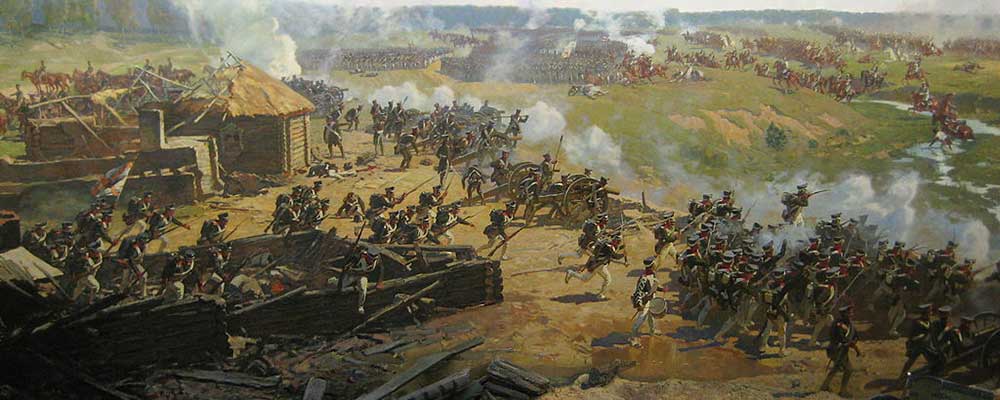
The Battle of Borodino was one of the Napoleonic Wars’ bloodiest and most contentious encounters. Marked as a pyrrhic victory for Napoleon Bonaparte, this battle paved the way for the capture of Moscow but ultimately failed to compel the Russian Empire to capitulate.
The Road to Borodino
In the summer of 1812, a definitive engagement became inevitable as Napoleon’s Grande Armée advanced deep into Russian territory. The French Emperor sought a decisive victory that would force Tsar Alexander I to negotiate. The Russian army, led by General Mikhail Kutuzov, stood at Borodino, about 70 miles west of Moscow. The battle was the climax of Napoleon’s Russian campaign, a gamble for a quick end to the invasion.
The Battlefield and Its Challenges
The terrain of Borodino, characterized by undulating hills and a series of ridges, played a significant role in the battle. The Russians constructed a series of defensive earthworks, known as redoubts, along the high ground, notably the Great Redoubt at the center of their line. These fortifications gave the Russian army solid defensive positions and limited their mobility.
Clash of Military Strategies
Napoleon’s strategy hinged on breaking the Russian center and splitting their army. He launched a series of frontal assaults against the Russian redoubts, which turned into grueling, attritional warfare. The Russians, for their part, fought tenaciously to hold their ground, launching several counterattacks. The fierce fighting at the Great Redoubt symbolized the battle’s intensity.
Tactically, both armies employed massive infantry columns supported by artillery. However, Napoleon refrained from committing his elite Imperial Guard, a decision that historians have widely debated.
The Aftermath and Its Significance
Though the French army managed to capture the key positions on the battlefield by the end of the day, the Russian forces were not decisively defeated and withdrew in good order. The high casualties suffered by the French and the exhaustion of their army rendered this victory ineffective in breaking the Russian resistance. The subsequent capture of Moscow did not lead to the anticipated Russian surrender.
Historical Perspectives
Contemporary accounts and later analyses of the Battle of Borodino often emphasize its brutality and the sheer scale of casualties on both sides. The battle is remembered for the Russian defense’s stubbornness and Napoleonic warfare’s limits. Memoirs and letters from soldiers provide a grim picture of the carnage and the challenging conditions of the Russian campaign.
In conclusion, the Battle of Borodino, though technically a win for Napoleon, epitomized the futility of his Russian campaign. It highlighted the limitations of military power against determined resistance and the vastness of Russia’s terrain, setting the stage for the disastrous retreat from Moscow that would follow.
The Dual Legacy of Napoleon’s Greatest Military Victories and Defeats
In retrospect, the saga of Napoleon Bonaparte is a compelling narrative of ambition, strategy, and the volatile nature of power. From the impressive triumphs at Austerlitz and Marengo to the devastating setbacks at Waterloo and Russia, Napoleon’s military career was marked by unparalleled genius and critical miscalculations. Napoleon’s greatest military victories not only reshaped the map of Europe but also revolutionized the art of warfare. Yet, these triumphs were countered by defeats that highlighted the limitations of even the most brilliant military minds when faced with the complexities of geopolitics, logistics, and human endurance.
The story of Napoleon serves as a timeless study of the balance of ambition and overreach, where each victory and defeat holds lessons in strategy, leadership, and the consequences of power. As history continues to ponder and analyze Napoleon’s legacy, his life remains a testament to the heights of success and depths of failure that can be achieved in the pursuit of glory and domination. His journey, etched in the annals of history, continues to fascinate and instruct, a reminder of the potential and the perils inherent in the quest for greatness.







